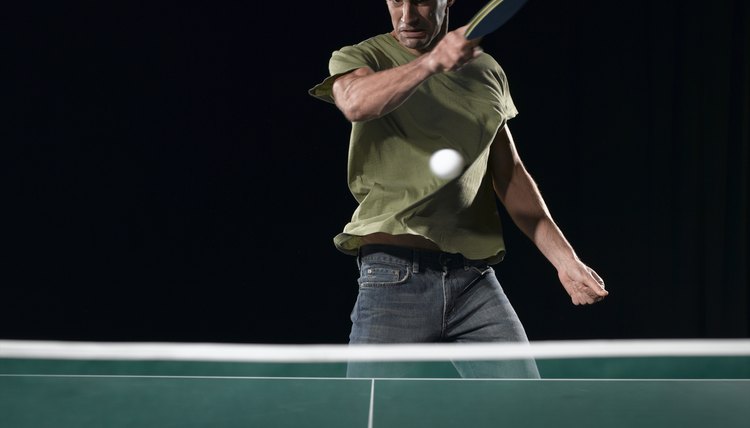Parts of a Table Tennis Racket

One of the main pieces of equipment needed to play table tennis is a racket, also referred to as a paddle or a bat. Rackets come premade and custom made. Advantages of premade rackets include lower cost and no assembly requirements. For custom rackets, the player has more options for the type of rubber used, but such rackets typically are more costly and require gluing on the rubber.
Blade
Multiple layers of wood stacked together make up the blade of a table tennis racket. Some blades also include layers of carbon fiber. The blade consists of a flat paddle area for hitting the ball and a handle. Two distinct styles of blades exist: the penhold style and the western or shakehand style. The way a player holds the racket determines the type of blade style. Asian players generally use the penhold grip, so the racket includes an area for the player to hold the handle between the thumb and the index finger. The western-style blade allows a player to hold the handle in the palm of the hand, using the same grip as when shaking hands.
The handle extends from the blade, with available options including a flat handle; a straight, rounded handle and a rounded, flared handle. Playing style and comfort determine the best handle grip choice for a player.
Table tennis rackets usually weigh 75 to 95 grams, according to All About Table Tennis.com. The blade types vary depending on the style of play, including an attacking or offensive style, a defensive style or an all-around style. Each style has different types of wood and allows for varying levels of power and control over the ball.
Rubber
A piece of rubber covers each side of the table tennis racket. For regulation play, the International Table Tennis Federation maintains a list of authorized rubbers and updates the list frequently. The rubber must be black on one side of the racket and red on the opposite side so the opposing player can easily determine the type of spin the player may place on the ball. Rubbers vary in thickness and pimple or pip style. Thicker rubber tends to help players with an offensive style of play. Inverted pimples have a smooth feel to the rubber that helps maintain good control of the ball. Pimple style rubbers include short and long pimple options. The short pimples are best for blocking actions, and long pimples tend to be helpful for defensive players. To be used in an official table tennis tournament, the brand logo must appear on the rubber to ensure it meets regulations, according to USA Table Tennis.
Glue
Custom rackets require gluing on the rubber. Maintaining the racket also requires periodically changing the rubber. Different types of glue can affect the speed of the ball. The preferred glue for table tennis rackets is a water-based glue free of harmful volatile compounds.
References
Resources
Writer Bio
Abigail Adams began her freelance writing career in 2009, teaching others about medical conditions and promoting wellness by writing on online health and fitness publications. She is educated and licensed as a registered nurse, having received her degree from North Georgia College and State University.
